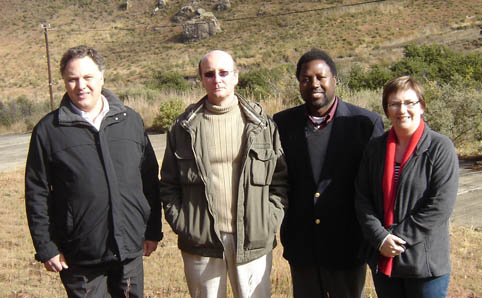 |
|
Some participants of the PED Nexus Programme during a field trip are from left: Jacques van Zuydam, Chief Director: Population and Development at the national Department of Social Development; Prof. André Pelser, course coordinator (UFS); Prof. Sosten Chiotha, Director, LEAD Southern and Eastern Africa; and Dr Nola Redelinghuys, course facilitator (UFS).
|
The University of the Free State (UFS) received a nod of approval at the COP 17 Climate Change Conference in Durban for a short course it presents in partnership with the Chief Directorate Population and Development, United Nations Populations Fund (UNFPA), LEAD International and SANParks.
The UFS received an honourable mention in a press release from the Department of Social Development for the short course entitled ‘Leadership Training in Sustainable Development: The Population, Environment and Development (PED) Nexus’. The release was issued as part of COP17. It mentions that the course is recognised in a publication of the United Nations Development Programme (UNDP) as one of ten innovative experiences and best practices in population and development in the developing world.
Prof. André Pelser, UFS Professor in Sociology, says the university played a key role in the development and implementation of the course. The UFS has been presenting the course since its inception in 2005. Similar courses under the banner of the PED Nexus, although in a totally different format, are also presented at the Nelson Mandela Metropolitan University and the University of Cape Town. A total of 21 courses have been presented nationwide since 2005, of which the UFS has hosted eight. More than 230 participants from all over the world have been trained in these eight short nine-day courses.
The PED Nexus Programme focuses on the interrelationships of population, environment and development and its significance for sustainable human development and is closely linked to the implementation of the national Population Policy for South Africa. The press release reads that the programme is implemented in the form of short courses that target professionals and managers in governments at all levels as well as non-governmental agencies responsible for the implementation of programmes related to sustainable development.
Prof. Pelser and Dr Nola Redelinghuys, also from the Department of Sociology, have recently been tasked by the National Department of Social Development to upgrade the course outline. The next course will run from 17-25 April 2012. As in the case of pervious courses, the first six days will be hosted on our main Campus in Bloemfontein, whereafter course participants and their facilitators depart to the Golden Gate Highlands National Park for the practical part of the course.